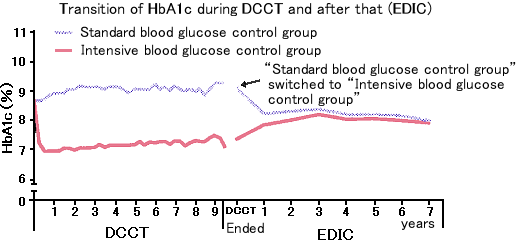いま、1型糖尿病は
2006年11月15日
16What were the results of DCCT / EDIC?
You probably know already about the Diabetes Control and Complications Trial (DCCT) study. To put it simply, the study conducted over about nine years involving about 1,440 American patients with type 1 diabetes, aimed to verify the hypothesis that keeping good control of blood glucose levels suppresses the onset and progression of diabetes complications.
The results showed that the hypothesis was right.
Keeping good control of blood glucose levels can suppress the onset and progression of diabetes complications.
Today, this has become a common-sense understanding. However, before the results of the study were released in 1993, there was no scientific study done to verify it. Although there was some idea back then that patients with good blood glucose control seemed less likely to develop complications, DCCT was the very first study that proved it beyond doubt.
DCCT Study
Just as I mentioned when I explained how clinical trials are conducted in one of the articles, patients were randomly assigned to two treatment groups in DCCT study: “intensive blood glucose control group” and “standard blood glucose control group.” Then, the study observed the degree of onset of complications in these two groups over about nine-year period.
DCCT/EDIC Study
After DCCT study was finished, volunteers were recruited from the “standard blood glucose control group” to be treated as “intensive blood glucose control group.” This means that both groups became “intensive blood glucose control group,” and researchers continued to study how the treatment will affect the onset of complications. This is what DCCT/EDIC study is about.
During the nine years of DCCT, the mean HbA1c for the “standard blood glucose control group” was 9% whereas it was 7% for the “intensive blood glucose control group.”
In DCCT/EDIC study, both groups were treated as “intensive blood glucose control group” with frequent insulin injections and so forth. HbA1c as of four, seven and eleven years after the start of the study has been reported so far. There was no difference found between the two groups, and the mean HbA1c was 8%.
Thus, as for the former “intensive blood glucose control group” of DCCT, HbA1c remained at around the same level with 7% during the nine years of DCCT and 8% during the eleven years of DCCT/EDIC. Likewise, as for the “standard blood glucose control group” of DCCT, HbA1c was 9% during DCCT and down to 8% and stayed around that level during DCCT/EDIC.

What about the onset of diabetes complications?
What findings were made about diabetes complications? The former “standard blood glucose control group” of DCCT showed improvement in blood glucose with HbA1c down to 8% during EDIC. However, when it comes to the onset of diabetic retinopathy, diabetic nephropathy and macrovascular complications (such as myocardial infarction and cerebral stroke), the study reported a significantly higher onset of such complications in that group compared to the “intensive blood glucose control group” of DCCT.
Metabolic Memory
What can be interpreted from the study is that “the effect of good blood glucose control of the past nine years continued at least for the next eleven years.” The results of the follow-up will be revealed continuously, so for how many years the effect will continue will become clear eventually. What can be said at this point is that the effect has continued at least for eleven years. Some researchers call this phenomenon “metabolic memory.” It is as if the body remembers good control of blood glucose levels of the past.
Postscript
Both Japan and other countries have seen a drastic increase in the number of diabetes patients. From a few years ago, a committee for the promotion of diabetes control (mainly comprised of the Japan Medical Association, the Japan Diabetes Society and the Japan Association for Diabetes and Care and supported by the Ministry of Health, Labor and Welfare) has been focusing on enhancing primary prevention of diabetes and preparedness for treatment of diabetes.
Also, large-scale, nationwide clinical trials, “Diabetes Outcome Intervention Trial (DOIT1, DOIT2, DOIT3)” (led by Japan Foundation for the Prevention of International Medical Research Cooperation, MHLW) and “randomized controlled trial on early diabetes intervention” (by Japan Early Diabetes Intervention Study or JEDIS supported by Japan Diabetes Foundation) began this year. In all these studies, participants will be provided high-quality, active treatment and control of lifestyle.
The results of these studies are expected to bring a new dimension to the treatment of diabetes in Japan.
If your doctor asks you to take part in one of these studies, I hope you will ask any questions or share your concerns with the doctor and then actively participate in the study.
©2006 Yasuko Uchigata
DCCT/EDICの結果は?
DCCT研究(Diabetes Control and Complications Trial)のことはもうみなさんご存知のことと思います。簡単に述べますと、良好な血糖コントロールをすれば糖尿病性合併症の発症や増悪が抑制されるかという疑問(「抑制される」と仮説する)に対して、1型糖尿病の患者さん(アメリカ1440名ほど)の協力のもとに、この仮説が正しいかどうかをおおよそ9年かけて検証した研究です。
結果は正しいということでした。
良好な血糖コントロールを続ければ合併症の発症および増悪が抑制できるということです。
今では当たり前のことですが、この結果が発表された1993年以前には、科学的な調査によってこれを検証したものはなかったのです。良好な血糖コントロールの患者さんは合併症になりにくいようだと思われていましたが、誰もが疑う余地のないくらいに検証されたDCCT研究の結果によって、はじめて明らかにされました。
DCCT時代の9年間の「これまで通りの血糖コントロール群」の平均HbA1cは9%、「良好な血糖コントロールを推し進める群」は平均7%でした。
DCCT/EDICになってから、両群とも(つまり全員)頻回注射などになって「良好な血糖コントロールを推し進める群」になったわけです。4年経過、7年経過、最近は11年経過した時点のHbA1cが報告されていますが、2群間の違いはなく、HbA1cの平均は8%です。
つまり、DCCT時代の「良好な血糖コントロールを推し進める群」はDCCT時代の9年間のHbA1c7%からDCCT/EDICの11年間は8%で、同様にDCCT時代の「これまでの血糖コントロール群」はHbA1c9%から8%に下がったまま推移してしたわけです。

付記 糖尿病は日本でも海外でも著しい患者数の増加を見せています。数年前から糖尿病対策推進会議(厚生労働省の支援で、日本医師会、日本糖尿病学会、日本糖尿病協会が中心)が糖尿病の一次予防、治療体制の充実に力をいれています。
また、今年から全国を対象にする大規模臨床研究として、2型糖尿病に対する「糖尿病予防のための戦略研究(DOIT1、DOIT2、DOIT3)」{(財)国際協力医学研究振興財団、厚労省}と「早期糖尿病の進展抑制に関する無作為化比較試験」{日本糖尿病進展抑制研究会(JEDIS)、(財)糖尿病財団}がはじまりました。どの研究でも質の高い積極的な治療や生活管理が行われます。
そして、これらの研究成果は、日本の糖尿病治療の新たな展開をもたらすものと期待されています。
もし、あなたがどれかの研究に該当するので参加していただけませんか?といわれたら、担当の先生に疑問や不安な点をよくお聞きした上で、積極的に参加されることを希望します。
※ヘモグロビンA1c(HbA1c)等の表記は記事の公開時期の値を表示しています。
Copyright ©1996-2024 soshinsha. 掲載記事・図表の無断転用を禁じます。
治療や療養についてかかりつけの医師や医療スタッフにご相談ください。

 医療・健康情報グループ検索
医療・健康情報グループ検索